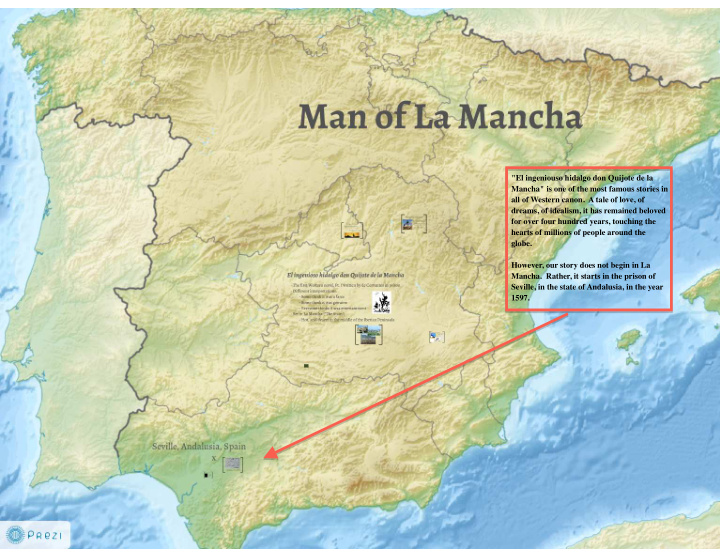



"El ingeniouso hidalgo don Quijote de la Mancha" is one of the most famous stories in all of Western canon. A tale of love, of dreams, of idealism, it has remained beloved for over four hundred years, touching the hearts of millions of people around the globe. However, our story does not begin in La Mancha. Rather, it starts in the prison of Seville, in the state of Andalusia, in the year 1597.
Seville is located at the site of the X, along the Guadalquivir River.
"La Casa de Contratacion," or "The House of An old map of Sevile Trade," was (dated 1860, but it established in 1503 works for our by a royal decree purposes). that made Seville the only Spanish city The prison is located allowed to trade with right by the river, at the New World; the red circle. since Spain would come to control What that means is almost the entirety of that the prison was the Americas over cold, dark, damp, and the next century, that generally very made Seville one of unpleasant. the wealthiest cities in Europe. The idea behind imprisonment at this However, this wealth time was not a did not trickle down restriction of freedom, to the common folk, but rather a "binding and thievery was an of the body" in order especially common to "allow the spirit to crime, following by be liberated." money-related murders. Lots of those too. It was scary.
Sorry, the real Miguel de Cervantes was definitely *not* a Don. But the playwrights needed to give him a manservant to play Sancho Panza, so we'll allow for the artistic liberties. Barbers and surgeons were generally the same person! They had the sharpest knives and the deftest hands. Still, they weren't educated in the sense that modern surgeons are. at the time of his imprisonment, as it says in the script. In 1492, all Jews were told to either convert to Christianity or leave Spain. It took a few decades, but his mother was born to one of these Spanish Jewish families that then converted to Catholicism. This injury left his left hand lame for the rest of his life. after four attempts at escaping... Travels the country collecting taxes for the next ten years, until he is arrested by the Inquisition. Here's another point where the script deviates from the history… He wasn't arrested because he served papers to a Church, he was arrested because he was inept at his job and lost track of a lot of money (some historians accuse him of embezzling the funds, in fact). Like I said earlier, prison wasn't so much about restriction-of-freedom-as-punishment, but removing people from the outside world in order to reflect on what they had done, repent, and bring their spirit closer to God. But yeah, this is musical theatre, so we'll allow them their artistic liberties. :-D
In any case, Miguel de Cervantes wrote Part I of *Don Quijote* in prison, dreaming of his homeland of La Mancha those many miles away...
This is Pablo Picasso's famous sketch, *Don Quixote*. (This is its English translation. It's a large area of red desert in the center of the peninsula. It looks like a red wine stain in the middle of the country!)
Some images of La Mancha. Toledo, a city that dates from the medieval ages! Olive fields. Olives are a MAJOR product of La Mancha. Lots of olive and goat farmers. The countryside: Hot, arid, mountainous.
But also, the southern part of La Mancha… It's covered in sunflowers. Sunflower seeds, oils, flowers, and other products are a major export of this region. Imagine an ocean of yellow and green, growing out of seas of red sand. It's simply breathtaking. This is the beauty of La Mancha, the magic of Don Quijote's world.
Famous opening line of *El Quijote*: "In a place in La Mancha, of whose name I don't care to remember…" Windmills can be giants. (The line is for scale.) Aldonza, the bar wench and inn prostitute, can become a beautiful and noble princess. Rocinante, an old, decrepit nag, can be a valiant steed. A barber-surgeon's shaving basin can be the Golden Helmet of Mambrino. Side note: Mambrino was a legendary Moorish king who supposedly had a helmet that made him invulnerable. It was a more obscure, "Holy Grail" type quest that Spanish knight-errants would take upon them in chivalry stories… Though doubtful that any did so in real life.
I say "roughly" because the musical *Man of La Mancha* and the novel "El ingenioso hidalgo don Quijote de la Mancha" don't exactly match up. Like I said, artistic license. Literally, he killed Quijote off to prevent any more impersonators from publishing stories about the hero. He was older, more jaded with years. While Part I was rather silly and lighthearted in tone, Part II devotes much more time to philosophical musings about the meaning of life and the nature of truth.
Guys, this story has been around for 400 years. Cervantes did something right. A story of hope and dreams, but also truth. A tale of reality, a tale of the impossible. Translation: "Too much sanity can be worse than craziness, to see life as it is and not as it should be."
Recommend
More recommend